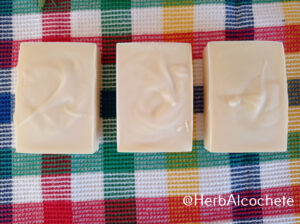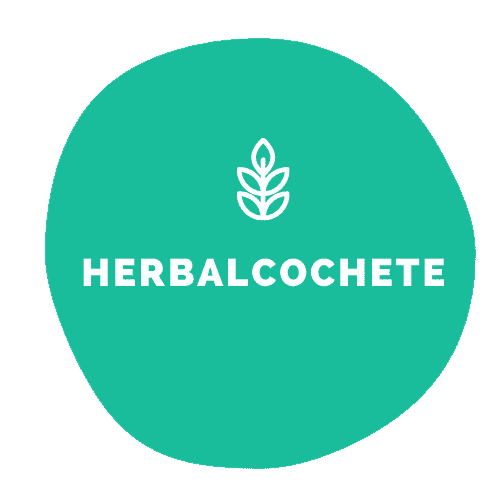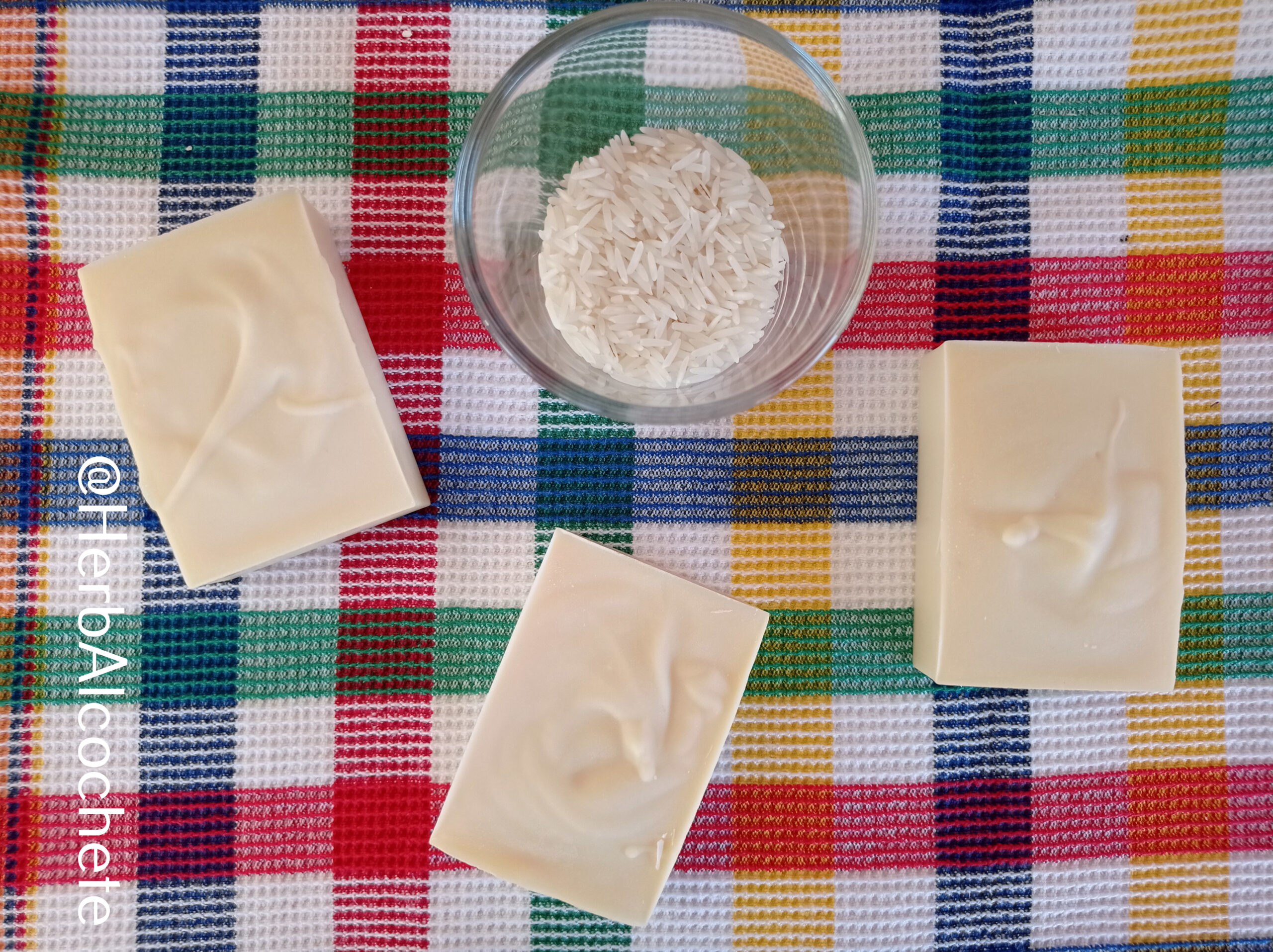Rice water is said to soothe and tone your skin, and even improve some skin conditions. Along with oatmeal, and moisturizing shea butter, this can be a good soap for skin conditions.
Try this rice water soap recipe, made with rice water as lye water. Rice water was made by simply straining water from soaked rice. With oatmeal flour and shea butter, and a flowery, very fragrant blend of essential oils. With no colorants, this soap takes a pretty creamy white natural color.
Learn how to make a wonderful soap with rice water.
Can I Use Rice Water In Soap?
Rice water can be used in soap incorporated in the lye water. Just replace part or, like in this recipe, the whole distilled water content with rice water when making the lye water. Then you do the rest of the soap as usual. Rice water will give your soap a nice creamy color, without other colorants.
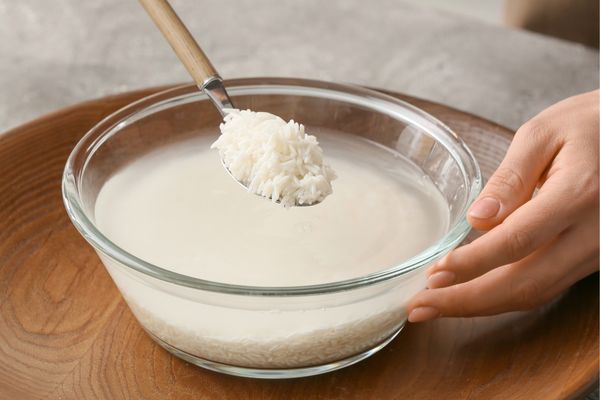
When doing the lye water with water enriched with plant material, like adding calendula petals or using orange juice, the smell is very strong and not pleasant at all. It smells something similar to ammonia. Like when you pour drain cleaner products in your kitchen pipes.
With rice water however, you just have a nice scent of cooked rice. Fortunately, or unfortunately in some cases, this lye water scent dissapears with curing, leaving the scent of soap salts and the essential oils you have used.
This smell that is released, when you add lye to plant material, is the reason why I think much of the plant properties are destroyed, or at least, changed when you are making soap. Therefore, when you are adding calendula petals to your soap, for example, and you believe you are benefitting from all its healing properties in soap? Hmm, I really doubt it.
Still, it works as a natural colorant, and it’s healthier compared with man-made colorants. As you can see from the pictures, rice water gives your soap a pretty creamy white color to the oils. With olive oil, who knows what would happen? Probably a yellow soap 🙂
Soaking Rice Water
You can make rice water at home by three ways: by boiling rice in water, by soaking rice in water or fermenting rice in water.
The process I’ve used in this soap, because it was the simplest of all, was to make rice water by soaking rice in water. You can also make rice water by soaking rice in water. Wash a cup of rice with water, then let it soak in 200ml of water for at least 30 minutes before pressing the rice and straining it through the sieve. Finally, refrigerate the rice water until you use it in your soap.
As usual, with time, I will experiment with the other methods of rice water.
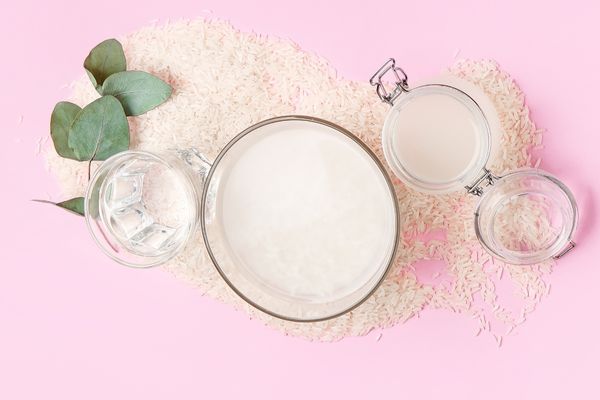
Does Rice Water Whiten Skin?
Many websites recommend using rice water to lighten the skin or reduce dark patches. In fact, a lot of commercial products contain rice water. Some people swear by its skin lightening powers. While some of the chemicals in it are known to lighten pigment, there are no evidences for how effective it is.
Give it a try with this soap in your face and see if it really lightens your skin or not. I will update this post with my own experiments about this rice water soap. But as I said before, I don’t really believe in its effect on soap, at least not to its fullest potential. It to be more effective applied on its own, as a tonic, or as part of a recipe lotion, where the rice water doesn’t go through heavy chemical changes.
Chech out about the benefits of rice water for your skin in this post from Healthcare.
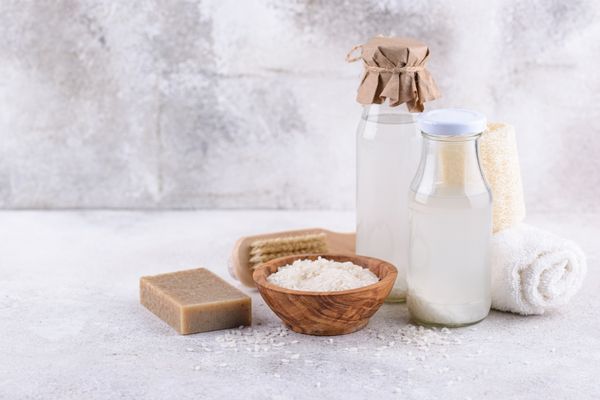
Is This Rice Soap Good For Skin?
Rice water has many properties good for skin. There’s evidence that it helps certain types of skin problems, like dry skin, eczema, acne, rashes and inflammation, sun damage and natural aging. It also repairs damaged hair.
Acting in a different way, with different nutrients, it’s somehow similar to oatmeal, a moisturizing and very soothing ingredient for skin, also good for skin conditions. By the way, this soap recipe also has oatmeal flour, as a scent fixer and as an addictive to make your soap softer.
Like I said before, I don’t really believe in rice water properties to fully survive saponification, the chemical reactions responsible for soap salts creation. Still, it is surely different from using plain water. Note that there are simply not enough studies to show that plant properties survive or not in handmade soap. It’s just in the “we don’t know” area. It’s my conviction they don’t survive completely, but I have no way of knowing how much of them do. I can only try the soap and see how different it is from the others.
To some people, adding rice water might turn handmade soap even milder, and soothing for their skin. To others it might not make a difference. If I had a skin condition, I’d definitely try this recipe, along with oatmeal and shea butter.
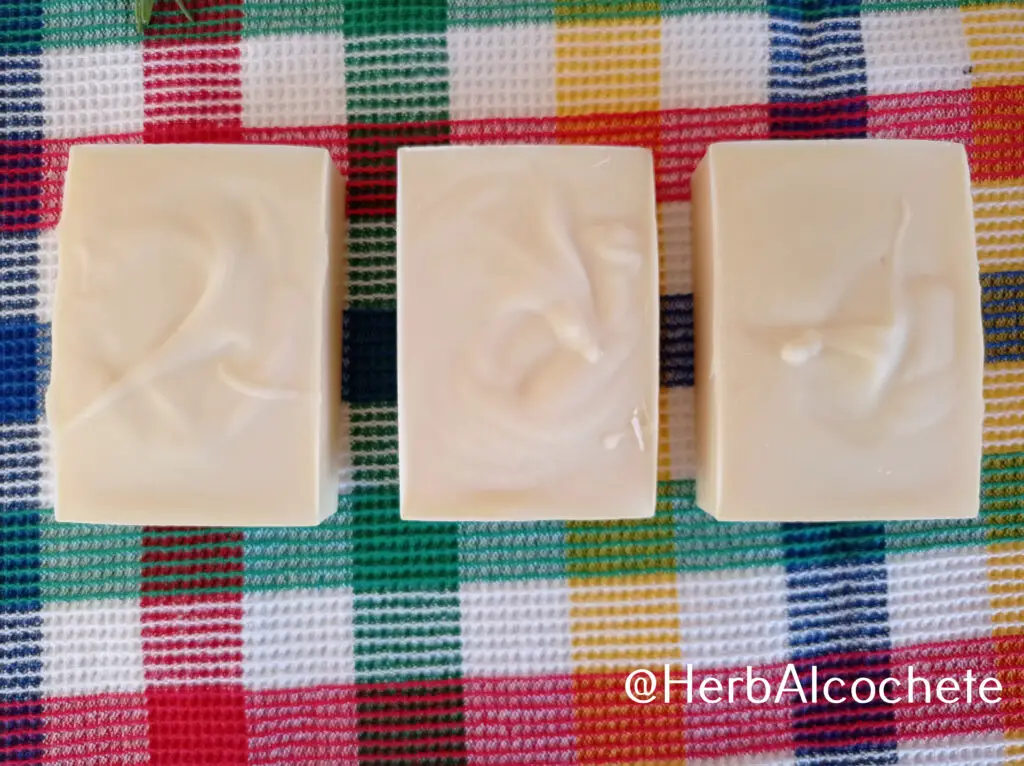
Rice Water Soap Recipe
I do like simple soaps, but I also like to test new things in soap. It’s part of the soap making bug, or passion, call it what you prefer 🙂 I am starting a set of soap recipes where I am testing different ways to make lye water: vegetable pureés and water infusions – we can see this rice water as a “water infusion”. Still, don’t worry, this is an easy soap recipe.
This soap is made with homemade rice water and oatmeal flour as ingredients that are known to soothe skin with conditions. Shea butter makes the soap creamier, more moisturizing. It has no coconut oil or olive oil, containing other oils such as palm oil, sunflower oil, sweet almond oil, castor oil and shea butter. It also has no colorants at all.
The essential oils blend is flowery: lavender, ylang-ylang and rose geranium. The scents last longer with the addition of oatmeal flour in the soap. They are a lovely blend that will light up your mood. Unless, of course, you’re not into flower scents. Then you can use your favorite essential oil blend – don’t forget to use a base essential oil to help last your scent.
With no colorants, and making the soap unscented – skipping the essential oils completely -, it’s a good recipe to try handmade soap to help relieve certain skin conditions. Especially if other solutions have not worked up to the moment. For sure, it’s a mild, soothing soap, even for normal skin. Maybe a good one when it’s summer and your skin is sunburned 🙂
Give it a try at this rice water soap recipe and enjoy your handmade soaps!!!

Find Out Where To Buy Handmade Rice Water Soap
So, you want to try handmade rice water soap, but are not into DIY? In Etsy, you will find real handmade soap, made only with oils and sodium hydroxide, and enriched with natural ingredients. Follow the links below and find out where to buy handmade rice water soaps for your skin:
- Rice Water Soap – Etsy
- Rice Milk Honey Soap – Etsy
- Honeysuckle Rice Milk Organic Soap – Etsy
Rice Milk Honey Soap - Etsy
How To Use This Soap
In the shower or bath, wet your hands and rub your soap in them to create a lather. Wash your hands first, then repeat the process and apply soap to your whole body using the soap directly and your hands. You may also wash your face with it. Rinse hands and body abundantly. Also wash your soap from lather before placing it in your soap dish or bag saver.
Washcloths and sponges should be avoided. Avoid washing your intimate zone and your hair, soap pH in not adequate for those parts of your body. Avoid eye contact with soap to prevent stinging. Make a patch test before using your soap. Stop using your soap if you feel any immediate adverse reaction in your skin (red skin, rashes, itching).
To take best advantage of your handmade soap (made by yourself or store-bougth), read How Do You Use Handmade Soap?
Related Posts
Ingredients and Recipes
- Vegetable oils: Oil Properties For Soap Making
- Essential oils: Best Essential Oils for Soap Making
- Colorants: How To Color Your Soap With Kitchen Ingredients
- Beginner Recipes: Soap Recipes for Beginners
- Cold Process Soap Recipes: Free Cold Process Soap Recipes
Soap Making Techniques and Troubleshooting
- Cold Process Tutorial Guide: Learn To Make Cold Process Soap?
- Soap Making Methods: How To Make Soap At Home
- Soap Making Trace: Know Everything About Trace in Soap Making
- Soap Acceleration: Causes, How To Avoid It Or How To Fix It
- Soda Ash In Soap: What It Is, How to Remove It
Watch This Video About Safety
Cold Process Soap Making Tutorial Video
Cold Process Soap Making Lessons
The tutorials in this blog are a great – and free! – help to start with cold process soap making. Practice is the next step to harness the art of making soaps at home. However, I understand if you prefer to have some formal lessons, where you will feel more supported with the steps. Feel free to join these courses at Udemy.
Equipment
Ingredients
Lye Water
- 151 g rice water
- 65 g lye (100% sodium hydroxide)
Oils/Fat
- 200 g RSPO palm oil
- 100 g sunflower oil
- 75 g sweet almond oil
- 75 g refined or organic shea butter
- 50 g castor oil
- 7 g colloidal oat powder
After Trace Ingredients
- 6 drops grapefruit seed extract (GSE) (anti-oxidant) or rosemary oleorresin extract
- 16 ml essential oils blend
Essential Oil Blend
Instructions
Get Ready!
- Wear goggles and gloves! Look at “Safety Precautions” in the video above or in Soap Making Safety Precautions
- Watch the video above about "Cold Process Soap Making Tutorial" or read the post Learn To Make Cold Process Soap for instructions on cold process soap making before starting. These are generic but important steps for all recipes.

- Prepare the rice water in advance: check Google for recipes on how to do it, there are several ways. I have simply added a cup of rice into 200 ml/6.76 fl oz of water and let it rest, mixing every now and then, for 30 minutes. I didn't let the rice to ferment.
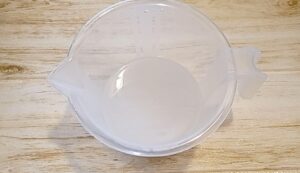
- Assemble everything: ingredients, equipment, safety equipment. Prepare your workstations. Measure all the ingredients. Don’t start the recipe without having everything ready!
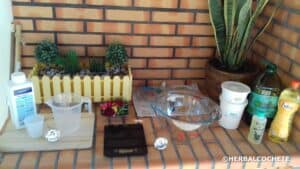
Heat the Oils
- Heat all your oils in a pyrex bowl at the microwave until the palm oil and shea butter melts. Use 1 min periods and check temperature. The oils shouldn't overheat (> 60 °C)75 g sweet almond oil
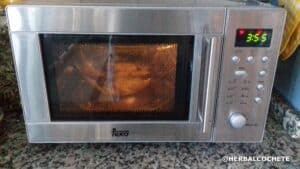
Make the Lye Water
- Make the lye solution according to How To Make Lye Water. Add the citric acid before the lye. Mix it well until the vapors start to dissipate.151 g rice water, 65 g lye (100% sodium hydroxide)

Make the Soap Batter
- Use as target temperature 25 °C for the oil-solution mixture. It can be less than this, but the lye and oils should not have a difference of more than 10ºC/ºF between them.

- Pour the lye water into the oils carefully, using a spatula or the edge of the bowl
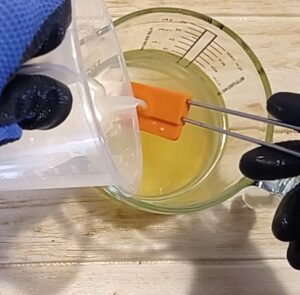
- Mix oils and lye with the immersion blender.
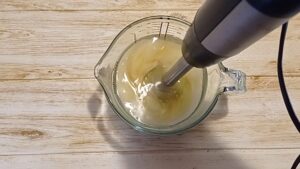
- Reach trace with the immersion blender.
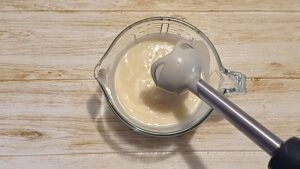
Add After Trace Ingredients
- Add the extract and the essential oil blend. Mix with a spoon or spatula. The soap might accelerate at this point, be ready to pour it in your molds afterwards.6 drops grapefruit seed extract (GSE) (anti-oxidant), 16 ml essential oils blend
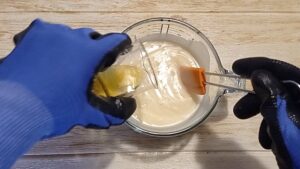
Molding and Curing
- Pour the dough in individual soap molds and sprinkle with alcohol or witch hazel. Let it set for 48 hours.
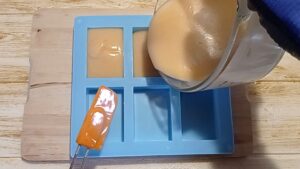
- Learn how to clean all equipment with How to Clean Soap Making Equipment.
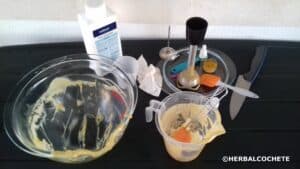
Cutting and Curing the Soap Bars
- Unmold the soaps after 48 hours and let the bars cure for 4 to 6 weeks in a ventilated place. See How To Cure Soap and How Do You Store Homemade Soap?

- Enjoy your soaps!!
